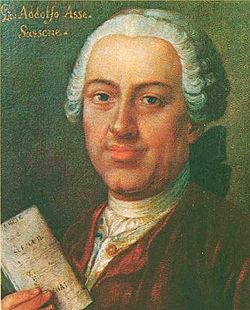| Piramo e Tisbe | |
|---|---|
| Opera by Johann Adolph Hasse | |
 The opera's composer, Johann Adolph Hasse | |
| Librettist | Marco Coltellini |
| Premiere | Autumn, 1768 |
Piramo e Tisbe is an opera in two acts, described by its composer as an intermezzo tragico, by Johann Adolf Hasse to a libretto by Marco Coltellini.
Contents
Piramo e Tisbe is based on the story of the lovers Pyramus and Thisbe as told in Ovid's Metamorphoses . The same story is parodied in Shakespeare's Midsummer Night's Dream , and this comic version of it forms the basis of the 1745 opera Pyramus and Thisbe by John Frederick Lampe, but Coltellini's libretto is a straightforward sentimental tragedy, in which the two eponymous lovers kill themselves, (as does Tisbe's father, who blames himself, having previously forbidden their love).
Piramo e Tisbe is more elaborately composed than Hasse's other operas, with accompanied recitatives and arias which are thorough-composed, that is, not merely strophic settings. Hasse wrote to a friend that he rated it "amongst the best works I have written".